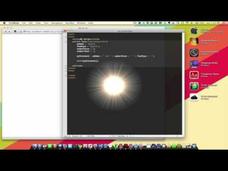Visual Learning Systems
Light: Electromagnetic Waves
Upon viewing the Light video series, students will be able to do the following: List some of the reasons light is important to all living things. Understand that light is a type of energy. Describe how light behaves both as a wave and as...
Curated Video
Making Inferences with Histograms in Basketball Analysis
This video uses the example of two basketball players to demonstrate how looking at multiple aspects of the data can lead to more informed inferences. By considering the players' scoring patterns and prior knowledge, we can predict who...
Brainwaves Video Anthology
Julie Lindsay - Teachers Make a Difference - Vic Connor
Julie is a global collaboration consultant, innovator, teacherpreneur and author. She has a 30+ years career in K-12 schools and higher education. She worked in international schools for fifteen years across Asia, Africa and the Middle...
XKA Digital
Selling is not about talp4
John Wagner is Director at Cycas Hospitality and has over 30 years' hotels sector experience with extensive knowledge of European hotel marketing, operations and development having lived and worked in Paris, Prague, London and Amsterdam....
XKA Digital
Selling is not about talking
John Wagner is Partner in Cycas Hospitality and has over 30 years' hotels sector experience with extensive knowledge of European hotel marketing, operations and development having lived and worked in Paris, Prague, London and Amsterdam....
The March of Time
1948: WASHINGTON, D.C.: THE WHITE HOUSE: WS Reception Hall double doors standing open, unidentified male walking into north building entrance escorted by male staff member, TD MS Presidential seal on floor.
MOT 1948: WASHINGTON, D.C.: THE WHITE HOUSE: WS Reception Hall double doors standing open, unidentified male walking into north building entrance escorted by male staff member, TD MS Presidential seal on floor.
ShortCutsTv
Unmasking: The End of Debate?
Unmasking is extreme form of criticism that is becoming increasingly prevalent in social science and everyday discourse where individuals are accused of being fraudulent and ideas are exposed as illusions, making debate and argument...
Curated Video
Writing and Solving Linear Equations: Analyzing Scenarios with Linear Relationships
Learn how to write and solve linear equations by examining real-life scenarios. Review examples such as calculating cab fare and determining how many months someone can afford rent before depleting their bank account. The lesson...
Blockchain Central
How VeChain Creates Secure Business Environment?
This week on Blockchain Central: we'll talk about VeChain, which is commonly known as the Ethereum for business. It aims to create mre transpatent production and supply chian by implementing blochchain-based business platforms.
APMonitor
Data Science 🐍 Install and Overview
Welcome to the course on data science with Python. This course steps through basic data science and machine learning skills to analyze data and create actionable information. It address major steps of the Cross-Industry Standard Process...
Macat
An Introduction to Edmund Gettier's Is Justified True Belief Knowledge?
Teenagers are at the perfect age to start holding strong beliefs and opinions—and to explore whether those beliefs are the same as having knowledge. A short video analysis of Edmund Gettier's paper "Is Justified True Belief Knowledge?"...
MinutePhysics
Albert Einstein: The Size and Existence of Atoms
How do you prove the existence of something you can't see? For Albert Einstein, a liberal application of math usually did the trick! Physics scholars discover the relationship between atomic size and the motion of larger particles...
The New York Times
Kiev in Chaos: Teaching About the Crisis in Ukraine
Provide a historical context for the political unrest between Russia and Ukraine that began in late 2013. Learners review their prior knowledge and chronicle new understandings with a KWL chart, watch a video explaining the Ukrainian...
Lifehacker
Learn to Code: Working with Variables
Building on prior knowledge about defining variables, the second video in this series on coding explains how to perform simple operations with data in JavaScript. Introducing first the concept of statements, the video goes on...
TED-Ed
On Reading the Koran
"The fact that so few people do actually read the Koran is precisely why it's so easy to misquote." How much are our ideas based on our own reasoning and evidence rather than secondhand information and the opinions of others? Lezley...
Fuse School
Covalent Bonding of Carbon Dioxide
How does a polar molecule, H2O, compare with a nonpolar molecule, CO2? Young chemists learn the similarities and differences between their covalent bonds and properties. They practice applying prior knowledge in a new way to reinforce...
JFR Science
pH and Kw
What is pH and where does it come from? Science superstars take their understanding of acids and bases to another level using a video from JFR Science. The narrator builds on prior knowledge to show viewers how to use what they already...
Teach Engineering
Storing Android Accelerometer Data: App Design
There's an app for that! Pupils learn to build an app that will store data on an Android. The lesson introduces class members to the tiny database, TinyDB, for Android devices. A video tutorial provides an example that uses the...
MinutePhysics
Upside Down Mountains in Real Life
A mountain gets smaller as you get to the top, right? It depends on how you look at it, because in terms of surface area, it may actually get bigger. Learners consider this idea as they view the creative video lesson.
SciShow
What Knocked Over Uranus? And Two Other Mysteries
It's no secret that most of the galaxy is a mystery. Data suggests that the known exoplanets may be most similar to our own neighborhood planet Uranus. Unfortunately, scientists know little about Uranus. The video lesson presenter...
Scholastic
Study Jams! Measure Length
Mia's pet lizard has grown a lot since he was a baby and she needs help measuring his length now that he's an adult. After choosing the best tool for the job, RJ goes step by step through the measurement process, modeling how to use both...
Brightstorm
The Geometric Representation of Vectors - Concept
What do you get when you cross a mosquito with a mountain climber? Nothing, you can't cross a vector and a scalar. The first video offers an explanation for how a geometric representation of vectors is helpful when adding and can be used...
Fuse School
What are Radioactive Isotopes (Radionuclides)
Create a little excitement with a radioactive resource! An engaging lesson builds a solid understanding of the nature of radioactive isotopes. The narrator explains the desire of a nucleus to become stable, which leads to radioactive...
Fuse School
Shielding
An atom's ability to lose an electron or attract an electron is not created equal! A thorough video lesson explains the concept of shielding and electron affinity. Learners understand the farther an electron is from the nucleus, the...













